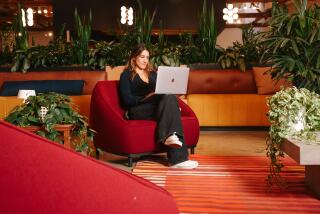Working during summer vacation? So are 61% of Americans
- Share via
As Americans, we like to say that we work hard and play hard. But what happens when work invades our play time?
A new survey conducted by Harris Interactive found that 61% of Americans plan to work during summer vacation this year, compared with 52% last year.
The survey of 1,094 employed Americans shows that the economy is pushing workers to do more.
Just ask John Husing, an economist from Redlands who communicated with clients and reporters by Internet during a recent adventure trip on a boat from Tasmania to the Antarctic coast.
“It’s the anxiety of not wanting to be out of the loop as a private business owner,” he said. “I don’t want to be thought of as not being available.”
But many Americans are not happy about giving up their vacation time for work.
The survey commissioned by the online meeting software company TeamViewer found that 34% of those surveyed plan to work but won’t be happy about it. And, yes, there is a small number (14%) who said they would be happy to work during vacation time.
Because the U.S. is now pulling out of the worst recessions in a generation, Husing said, workers want to do what it takes to make their bosses happy.
“The ghost of this is going to hang around for a long time,” he said.
But there are a few, about 22%, who said they would refuse to work during vacation, with 2% saying they would quit their job if they had to.
Others would simply vent by throwing something (4%) or crying (3%), the survey said.
Onboard with paying extra
Despite lots of grousing by air travelers, the upselling of onboard extras such as meals, entertainment and wireless Internet has surged over the last few years, with sales of upgraded seats growing the fastest.
Fliers ages 18 to 34 are the airline industry’s best customers for onboard extras, which means the sales are likely to continue growing for years to come, according to travel research company PhoCusWright.
“We are all captive and we want access to the Internet and we want to be able to eat something more than peanuts and stale pretzels and we don’t have much choice,” said Douglas Quinby, one of the authors of the study, based on a survey of 2,500 leisure travelers from the U.S.
In 2010, only 28% of leisure travelers bought in-flight snacks and meals, but that rate grew to 40% in 2012, according to the study. The sale of in-flight movies and entertainment jumped to 23% in 2012 from 15% in 2010, the study found.
The number of travelers paying to upgrade their seats grew to 23% in 2012 from 13% in 2010, the study found.
Younger fliers are more likely to spend on the add-ons, either because they are unfamiliar with the glory days when all the extras were included in the cost of an airline ticket, or because they are more accepting of the new fees than older travelers, Quinby said.
Money-saving tips
With airlines operating on a razor-thin profit margin, carriers are pulling out all the stops to cut costs.
The latest example is United Airlines, which plans to install new angled tips to the end of wings on more than 140 of its 737 jets beginning next year.
The aerodynamically shaped tips, known as “Scimitar winglets,” can save as much as 2% on fuel by reducing drag. The airline predicts that, once the winglets are installed on all of United’s 737, 757 and 767 planes, it can save more than $200 million a year in fuel costs.
“We are always looking for opportunities to reduce fuel expenses by improving the efficiency of our fleet,” said Ron Baur, United’s fleet vice president.
Angled wing tips are not new. Several carriers, including Southwest Airlines, have already added upturned tips to their planes’ wings.
The Scimitar winglets, however, add two tips to each wing, one that turns up like a shark’s dorsal fin and another that angles down like a pectoral fin.
More to Read
Inside the business of entertainment
The Wide Shot brings you news, analysis and insights on everything from streaming wars to production — and what it all means for the future.
You may occasionally receive promotional content from the Los Angeles Times.










